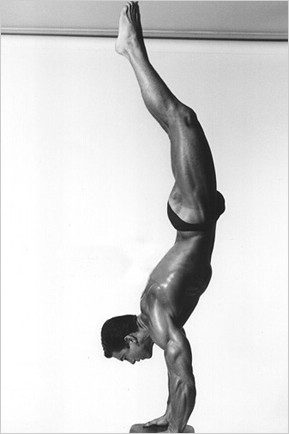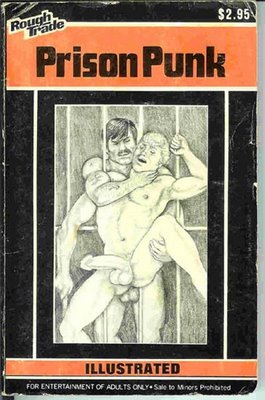Vintage Thursday
The Nazi Persecution of Homosexuals
A pink triangle, two-and-three-quarter inches high, worn on the left side of the jacket and on the right leg of the trousers, was the symbol which branded the homosexual inmates of the Nazi concentration camps. Most of them perished. In the words of a non-gay survivor: "I saw quite a number of pink triangles. I don't know how they were eventually killed. ... One day they were simply gone." The daily agony of their lives is recalled by Dr L.D. Claassen von Neudegg, a gay survivor of the Sachsenhausen camp:
After roll call on the evening of June 20, 1942, an order was suddenly given: "All prisoners with the pink triangle will remain standing at attention!" Our detail commander barked: "Three hundred criminal deviants, present as ordered!" We were registered, and then it was revealed to us that in accordance with an order from the Reichsfuehring SS, our category was to be isolated in an intensified- penalty company, and we would be transferred as a unit to the Klinker Brickwords the next morning. The Klinker factory! We shuddered, for the human death mill was more than feared. ... Forced to drag along twenty corpses, the rest of us encrusted with blood, we entered the Klinker works. ... We had been here for almost two months, but it seemed like endless years to us. When we were "transferred" here, we had numbered around 300 men. Whips were used more frequently each morning, when we were forced down into the clay pits under the wailing camp sirens. "Only 50 are still alive," whispered the man next to me. "Stay in the middle — then you won't get hit so much."
Hatred of Homosexuals
With such a rabidly heterosexual world-view, it is not difficult to understand the Nazi's hatred of homosexuals. In a nation obsessed with the birth-rate, homosexuality was a political crime. Rudolf Diels, founder of the Gestapo, in 1934 lectured his colleagues on how homosexuals had caused the downfall of ancient Greece. In 1935 all local police departments were required to submit to the Gestapo lists of suspected homosexuals; shortly there were 20,000 names on the index.
Reich Legal Director Hans Frank in 1938 issued orders for more rigorous surveillance:
Particular attention should be addressed to homosexuality, which is clearly expressive of a disposition opposed to the normal national community. Homosexual activity means the negation of the community as it must be constituted if the race is not to perish. That is why homosexual behaviour, in particular, merits no mercy.
Himmler's Division II was responsible for the control of "illegal parties and organizations, leagues and economic groups, reactionaries and the Church, freemasonry, and homosexuality." Even after serving their prison sentences, such "enemies of the state" were taken into "protective custody" (Schutzhaft) — a euphemism for internment in concentration camps.
Heinrich Himmler
The one man most directly responsible for the Nazi persecution of homosexuals was Heinrich Himmler. We have already noted that he was a fanatic heterosexualist. On the other side of the coin, he was a fanatic anti-homosexualist. By early 1937 gay men were being purged from his SS troups at the rate of merely one a month, but in that year Himmler gave a speech branding homosexuals as mentally diseased, effeminate, cowardly, liars, traitors, irresponsible and disloyal.
In his address to the Bad Tölz conference he ordered that gay SS men should be routed out, stripped of rank, expelled, court martialed, and imprisoned for the duration allowed by Paragraph 175. This was accompanied by private instructions to his generals:
After serving the sentence imposed by the court, they will, on my instructions, be taken to a concentration camp and there shot while attempting to escape.
The Concentration Camps
Male homosexuals were the lowest of the low. They were placed in the Level 3 camps: Dachau, Fühlsbüttel, Grossrosen, Lichtenburg, Mauthausen, Neuengamme, Ravensbrück and Sonnenburg. There they were placed under "triple camp discipline," which meant that they were subjected to harder work, less food, and stricter supervision than the other inmates. When they fell sick they were not allowed treatment in the clinics, and were left to die or were killed with large injections of morphine.
A survivor of one of these camps reports on the arrival of a new homosexual inmate, a healthy young man:
When he arrived, he was seized and ridiculed, then beaten and kicked, and finally spat upon. He suffered alone and in silence. Then they put him under a cold shower. It was a frosty winter evening, and he stood outside the barracks all through that long, bitterly cold night.
When morning came, his breathing had become an audible rattle. He was again beaten and kicked. Then he was tied to a post and placed under an arc lamp until he began to sweat, again put under a cold shower, and so on. He died toward evening. Bronchial pneumonia was given as the cause of his death.
Another survivor writers:
I saw a rather effeminate young man who was repeatedly forced to dance in front of SS men, who would then put him on the rack — chained hand and foot to a crossbeam in the guard-house barracks — and beat him in the most awful way. Even today I find it impossible to think back on all my comrades, all the barbarities, all the tortures, without falling into the deepest depression.
Quotas were regularly raised; men who collapsed were dragged away — often not to be seen again. The alleged idea behind the hard work was to make them "normal". This was supplemented by primitive aversion therapy and medical experimentation having little to do with so-called "cures." Neudegg recalls:
Experiments had been ordered involving living subjects and phosphorus: methods of treating phosphorus burns were to be developed and tested. I must be silent about the effects of this series of experiments, which proceeded with unspeakable pain, fear, blood and tears: for it is impossible to put the misery into words.
Gay men were given the opportunity to undergo "renunciation tests" under Himmler's orders, but even if the gay men "passed" the test and succeeded in being aroused by the prostitutes provided for them, they were not released. Few of the men gave up their homosexuality. Hoess reports: "Whenever they found an opportunity, they would fall into one another's arms." And "knowing they would never be set free," they suffered additional psychological stress. Their work became even harder, and they died like flies.
Hoess observed that many gay men in his camps formed deep and lasting relationships:
Should one of these lose his "friend" through sickness, or perhaps death, then the end could at once be foreseen. Many would commit suicide. To such natures, in such circumstances, the "friend" meant everything. There were many instances of "friends" committing suicide together.
But on the whole, many of the men with the pink triangles — especially the Strichjungen and the most swishy gays — did not give up without a struggle. As Hoess coldly remarks: "It was often not easy to drive them to the gas chambers."
The Death Toll
No one knows how many homosexual men were killed by the Nazis before and during the war. But let us look at some figures.
First, on the home front. The number of homosexual men (non-military) convicted under Paragraph 175 and sent to prison were:
* 835 in 1933
* 948 in 1934
* about 3700 in 1935
* 5321 in 1936
* 8721 in 1937
* 8115 in 1938
* 7614 in 1939
* 3773 in 1940
* 3735 in 1941
* 2678 in 1942
* 996 in the first quarter of 1943
By all accounts, hardly any of the homosexual inmates of the concentration camps survived. The pink triangles were spurned by all other groups in the concentration camps, and most non-gay survivors even today refuse to acknowledge the existence of their fellow gay prisoners. After the war, homosexuals were denied the reparations given by the German government to other groups, because they were still classified as criminals under German law. They were even denied state pensions to compensate for the amount of time spent in the concentration camps. They could be re-imprisoned for "repeat offences," and were kept on the modern lists of "sex offenders." The humane institutions of every country have condemned the treatment of all of the victims — except for homosexuals. On annual days of mourning for the victims, few countries officially mourn for homosexuals. To the survivor's comment that "one day they were simply gone" we might add "and today are all but forgotten."









1 comment:
That was a very interesting account and fact finding post. Thank you for sharing.
Post a Comment